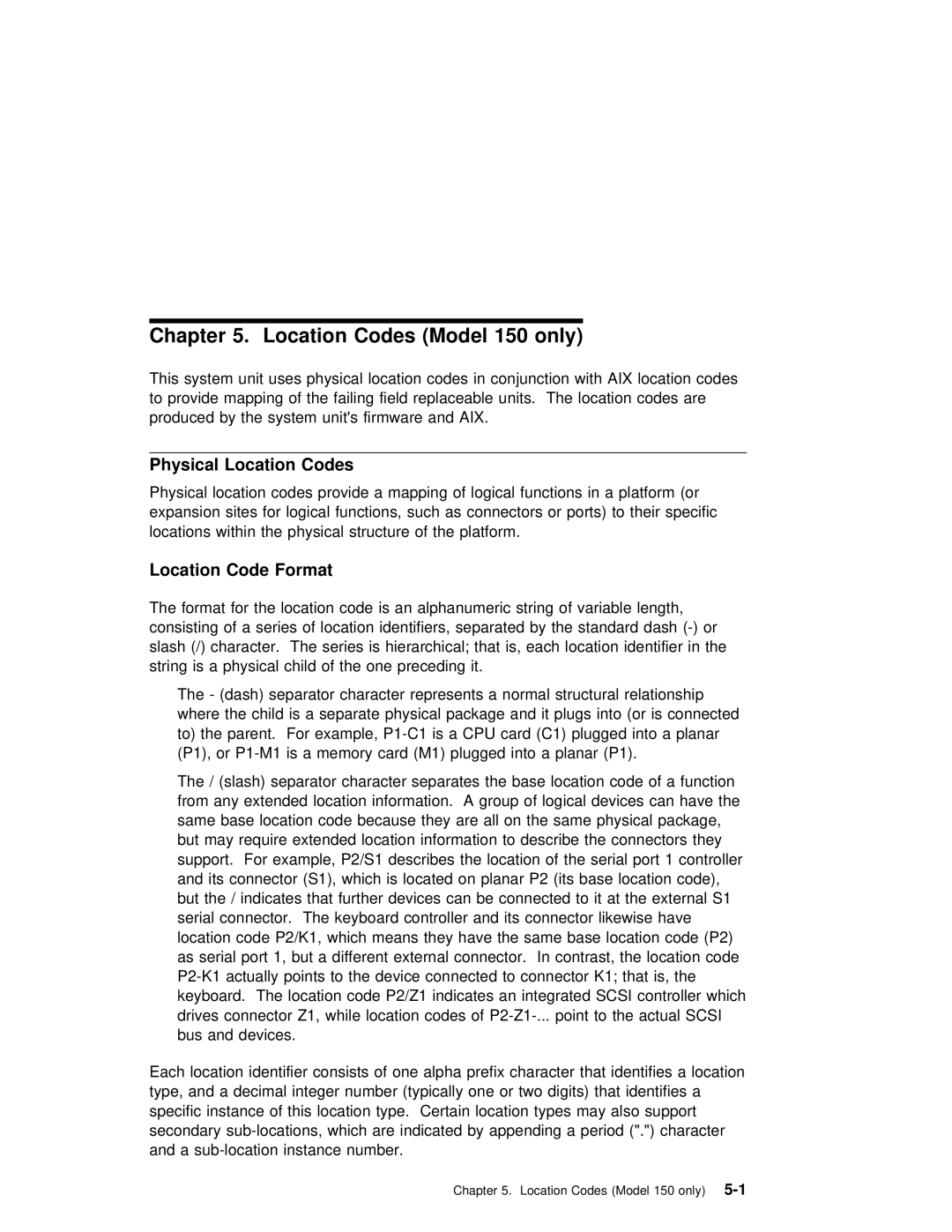Chapter | 5. Location | Codes | (Model 150 | only) |
|
|
|
|
|
|
|
|
|
|
|
|
|
| |||||||
This | system | unit | uses | physical | location | codes | in | conjunction | with | AIX | location | code | |||||||||||||
to provide mapping of the failing | field | replaceable | units. The | location | codes | are | |||||||||||||||||||
produced | by the system unit's firmware and AIX. |
|
|
|
|
|
|
|
|
|
| ||||||||||||||
|
|
|
|
|
|
|
|
|
|
|
|
|
|
|
|
|
|
|
|
|
|
|
| ||
Physical | Location | Codes |
|
|
|
|
|
|
|
|
|
|
|
|
|
|
|
|
|
|
|
|
| ||
Physical | location | codes | provide | a | mapping |
| of | logical | functions in | a | platform | (or | |||||||||||||
expansion | sites | for | logical | functions, | such | as | connectors | or | ports) | to | their | speci | |||||||||||||
locations | within | the | physical | structure | of | the platform. |
|
|
|
|
|
|
|
|
| ||||||||||
Location | Code | Format |
|
|
|
|
|
|
|
|
|
|
|
|
|
|
|
|
|
|
|
|
|
| |
The format | for | the | location | code | is | an |
| alphanumeric | string | of | variable | length, |
| ||||||||||||
consisting | of a series of location identifiers, separated by the standard dash | ||||||||||||||||||||||||
slash | (/) | character. The series | is | hierarchical; | that | is, | each location identifi | ||||||||||||||||||
string | is | a | physical | child | of | the | one | preceding | it. |
|
|
|
|
|
|
|
|
| |||||||
ŸThe - (dash) separator character represents a normal structural relationship
| where | the | child | is | a separate | physical | package | and it plugs into (or | is | co | |||||||||||||||||||
| to) | the | parent. For | example, |
| (C1) |
| plugged | into | a | planar |
| |||||||||||||||||
| (P1), | or | is | a | memory | card | (M1) | plugged | into | a | planar |
| (P1). |
|
|
|
|
| |||||||||||
Ÿ | The | / | (slash) | separator | character | separates | the | base location code of a f | |||||||||||||||||||||
| from | any | extended | location information. A group of | logical | devices | can | have the | |||||||||||||||||||||
| same | base | location | code | because | they are |
| all | on | the | same | physical | package, | ||||||||||||||||
| but | may require extended location information to describe the connectors they | |||||||||||||||||||||||||||
| support. For | example, | P2/S1 | describes | the | location | of | the |
| serial | port | 1 | contro | ||||||||||||||||
| and | its | connector | (S1), | which is | located | on |
| planar | P2 | (its |
| base | location | code | ||||||||||||||
| but | the / indicates that further devices can | be connected | to | it | at | the | e | |||||||||||||||||||||
| serial connector. The keyboard controller and its connector likewise have |
|
| ||||||||||||||||||||||||||
| location | code | P2/K1, | which | means | they | have | the | same | base | location | code | (P2) | ||||||||||||||||
| as | serial | port | 1, | but | a | different | external | connector. In | contrast, | the | locati | |||||||||||||||||
| to the device connected to connector K1; that is, the |
| |||||||||||||||||||||||||||
| keyboard. The location code P2/Z1 indicates an integrated | SCSI | controller | which | |||||||||||||||||||||||||
| drives | connector | Z1, while | location | codes | of | point | to | the | actual | SCSI | ||||||||||||||||||
| bus | and | devices. |
|
|
|
|
|
|
|
|
|
|
|
|
|
|
|
|
|
|
|
|
|
| ||||
Each location identifier consists of one | alpha | prefix | character | that | identifies | ||||||||||||||||||||||||
type, | and a decimal integer number (typically one or two | digits) that | identifies | ||||||||||||||||||||||||||
specific instance of this location type. Certain location types may also support |
| ||||||||||||||||||||||||||||
secondary | which | are | indicated | by | appending | a | period | (".") charact | |||||||||||||||||||||
and | a | instance | number. |
|
|
|
|
|
|
|
|
|
|
|
|
|
|
|
|
|
|
| |||||||
Chapter 5. Location Codes (Model
